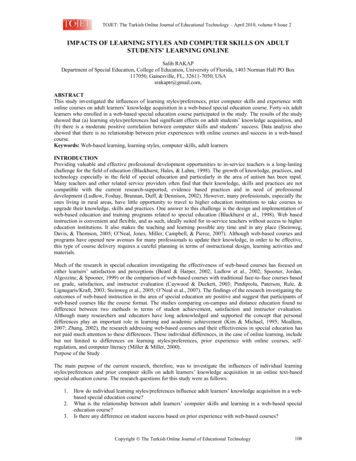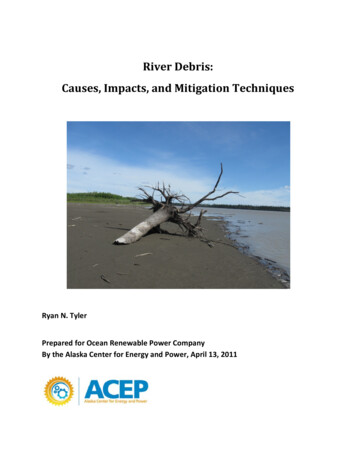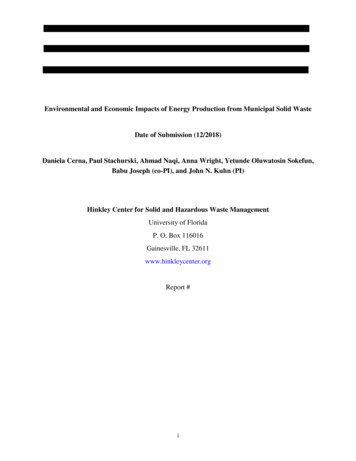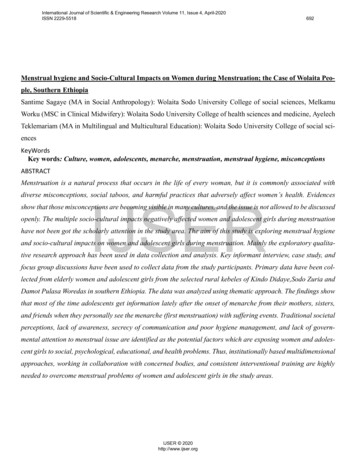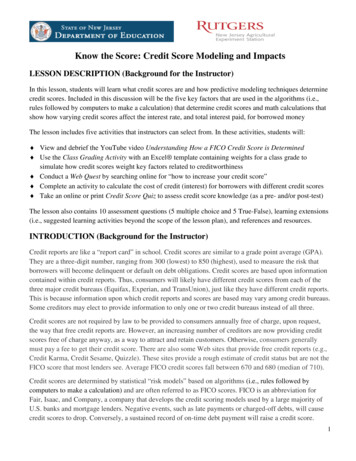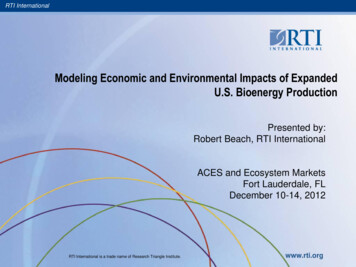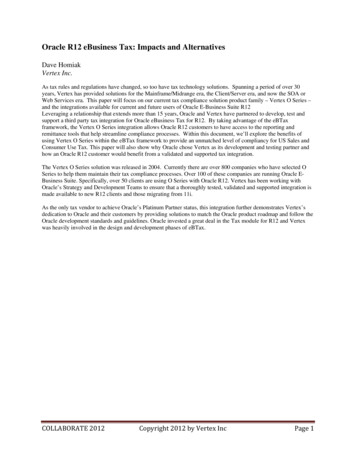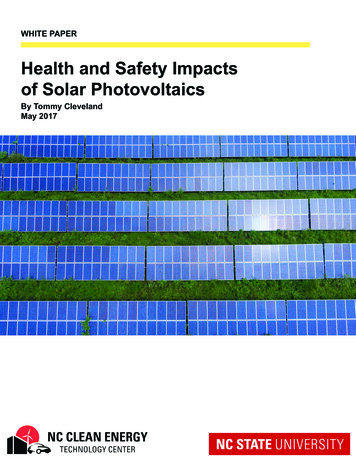
Transcription
WHITE PAPERHealth and Safety Impactsof Solar PhotovoltaicsBy Tommy ClevelandMay 2017
Contents1.1 Project Installation / Construction.41.2 System Components 1.2.1 Solar Panels: Construction and Durability.51.2.2 Photovoltaic (PV) Technologies.71.2.3. Panel End-of-Life Management.101.2.4 Non-Panel System Components (racking, wiring, inverter, transformer).121.4 Operations and Maintenance – Panel Washing and Vegetation Control.132 Electromagnetic Fields (EMF).143 Electric Shock and Arc Flash Hazards .164 Fire Safety.16Summary.17
Health and Safety Impacts of SolarPhotovoltaicsThe increasing presence of utility-scale solar photovoltaic (PV) systems (sometimes referred to assolar farms) is a rather new development in NorthCarolina’s landscape. Due to the new and unknown nature of this technology, it is natural forcommunities near such developments to be concerned about health and safety impacts. Unfortunately, the quick emergence of utility-scale solarhas cultivated fertile grounds for myths and halftruths about the health impacts of this technology,which can lead to unnecessary fear and conflict.This is in addition to the value of the electricity andsuggests that the air quality benefits of solar areworth more than the electricity itself.Even though we have only recently seen largescale installation of PV technologies, the technology and its potential impacts have been studiedsince the 1950s. A combination of this solar-specific research and general scientific research hasled to the scientific community having a good understanding of the science behind potential healthand safety impacts of solar energy. This paper utiPhotovoltaic (PV) technologies and solar inverters lizes the latest scientific literature and knowledgeare not known to pose any significant health dan- of solar practices in N.C. to address the healthgers to their neighbors. The most important dan- and safety risks associated with solar PV technolgers posed are increased highway traffic during ogy. These risks are extremely small, far less thanthe relative short construction period and dangers those associated with common activities such asposed to trespassers of contact with high voltage driving a car, and vastly outweighed by health benequipment. This latter risk is mitigated by signage efits of the generation of clean electricity.and the security measures that industry uses todeter trespassing. As will be discussed in more This paper addresses the potential health anddetail below, risks of site contamination are much safety impacts of solar PV development in Northless than for most other industrial uses because Carolina, organized into the following four categoPV technologies employ few toxic chemicals and ries:those used are used in very small quantities. Due (1) Hazardous Materialsto the reduction in the pollution from fossil-fu- (2) Electromagnetic Fields (EMF)el-fired electric generators, the overall impact of (3) Electric Shock and Arc Flashsolar development on human health is overwhelm- (4) Fire Safetyingly positive. This pollution reduction results froma partial replacement of fossil-fuel fired generationby emission-free PV-generated electricity, whichreduces harmful sulfur dioxide (SO2), nitrogen oxides (NOx), and fine particulate matter (PM2.5). One of the more common concerns towards solarAnalysis from the National Renewable Energy is that the panels (referred to as “modules” in theLaboratory and the Lawrence Berkeley National solar industry) consist of toxic materials that enLaboratory, both affiliates of the U.S. Department danger public health. However, as shown in thisof Energy, estimates the health-related air quali- section, solar energy systems may contain smallty benefits to the southeast region from solar PV amounts of toxic materials, but these materials dogenerators to be worth 8.0 per kilowatt-hour of not endanger public health. To understand potensolar generation.1tial toxic hazards coming from a solar project, one1 Hazardous MaterialsMay 2017 Version 13
must understand system installation, materialsused, the panel end-of-life protocols, and systemoperation. This section will examine these aspectsof a solar farm and the potential for toxicity impacts in the following subsections:(1.2) Project Installation/Construction(1.2) System Components1.2.1 Solar Panels: Construction and Durability1.2.2 Photovoltaic technologies(a) Crystalline Silicon(b) Cadmium Telluride (CdTe)(c) CIS/CIGS1.2.3 Panel End of Life Management1.2.4 Non-panel System Components(1.3) Operations and Maintenance1.1 Project Installation/ConstructionThe system installation, or construction, processdoes not require toxic chemicals or processes. Thesite is mechanically cleared of large vegetation,fences are constructed, and the land is surveyedto layout exact installation locations. Trenches forunderground wiring are dug and support posts aredriven into the ground. The solar panels are bolted to steel and aluminum support structures andwired together. Inverter pads are installed, andan inverter and transformer are installed on eachpad. Once everything is connected, the system istested, and only then turned on.Figure 1: Utility-scale solar facility (5 MWAC) located in Catawba County. Source: Strata SolarMay 2017 Version 14
1.2 System Components1.2.1 Solar Panels: Construction and DurabilitySolar PV panels typically consist of glass, polymer,aluminum, copper, and semiconductor materialsthat can be recovered and recycled at the end oftheir useful life.2 Today there are two PV technologies used in PV panels at utility-scale solar facilities, silicon, and thin film. As of 2016, all thin filmused in North Carolina solar facilities are cadmiumtelluride (CdTe) panels from the US manufacturerFirst Solar, but there are other thin film PV panelsavailable on the market, such as Solar Frontier’sCIGS panels. Crystalline silicon technology consists of silicon wafers which are made into cellsand assembled into panels, thin film technologiesconsist of thin layers of semiconductor materialdeposited onto glass, polymer or metal substrates.While there are differences in the components andmanufacturing processes of these two types of solar technologies, many aspects of their PV panelconstruction are very similar. Specifics about eachtype of PV chemistry as it relates to toxicity arecovered in subsections a, b, and c in section 1.2.2;on crystalline silicon, cadmium telluride, and CIS/CIGS respectively. The rest of this section appliesequally to both silicon and thin film panels.To provide decades of corrosion-free operation,PV cells in PV panels are encapsulated from airand moisture between two layers of plastic. Theencapsulation layers are protected on the top witha layer of tempered glass and on the backsidewith a polymer sheet. Frameless modules includea protective layer of glass on the rear of the panel, which may also be tempered. The plastic ethylene-vinyl acetate (EVA) commonly provides thecell encapsulation. For decades, this same material has been used between layers of temperedglass to give car windshields and hurricane windows their great strength. In the same way thata car windshield cracks but stays intact, the EVAlayers in PV panels keep broken panels intact(see Figure 4). Thus, a damaged module does notgenerally create small pieces of debris; instead, itlargely remains together as one piece.May 2017 Version 15
Figure 4: The mangled PV panels in this picture illustrate the nature of broken solar panels;the glass cracks but the panel is still in one piece. Image Source: http://img.alibaba.com/photo/115259576/broken solar panel.jpgPV panels constructed with the same basic components as modern panels have been installedacross the globe for well over thirty years.3 Thelong-term durability and performance demonstrated over these decades, as well as the results ofaccelerated lifetime testing, helped lead to an industrystandard 25-year power production warranty for PV panels. These power warranties warranta PV panel to produce at least 80% of their original nameplate production after 25 years of use. Arecent SolarCity and DNV GL study reported thattoday’s quality PV panels should be expected toreliably and efficiently produce power for thirty-fiveyears.4Local building codes require all structures, including ground mounted solar arrays, to be engineeredto withstand anticipated wind speeds, as definedby the local wind speed requirements. Many rackMay 2017 Version 1ing products are available in versions engineeredfor wind speeds of up to 150 miles per hour, whichis significantly higher than the wind speed requirement anywhere in North Carolina. The strength ofPV mounting structures were demonstrated duringHurricane Sandy in 2012 and again during Hurricane Matthew in 2016. During Hurricane Sandy,the many large-scale solar facilities in New Jersey and New York at that time suffered only minordamage.5 In the fall of 2016, the US and Caribbean experienced destructive winds and torrentialrains from Hurricane Matthew, yet one leading solar tracker manufacturer reported that their numerous systems in the impacted area received zerodamage from wind or flooding.6In the event of a catastrophic event capable of damaging solar equipment, such as a tornado, the system will almost certainly have property insurance6
that will cover the cost to cleanup and repair theproject. It is in the best interest of the system owner to protect their investment against such risks. Itis also in their interest to get the project repairedand producing full power as soon as possible.Therefore, the investment in adequate insuranceis a wise business practice for the system owner.For the same reasons, adequate insurance coverage is also generally a requirement of the bank orfirm providing financing for the project.of most panels. The PV cell itself is nearly 100%silicon, and silicon is the second most commonelement in the Earth’s crust. The silicon for PVcells is obtained by high-temperature processingof quartz sand (SiO2) that removes its oxygenmolecules. The refined silicon is converted to aPV cell by adding extremely small amounts of boron and phosphorus, both of which are commonand of very low toxicity.The other minor components of the PV cell arealso generally benign; however, some containlead, which is a human toxicant that is particularlyharmful to young children. The minor componentsinclude an extremely thin antireflective coating(silicon nitride or titanium dioxide), a thin layer ofa. Crystalline Siliconaluminum on the rear, and thin strips of silver alloythat are screen-printed on the front and rear of cell.7This subsection explores the toxicity of sili- In order for the front and rear electrodes to makecon-based PV panels and concludes that they do effective electrical contact with the proper layer ofnot pose a material risk of toxicity to public health the PV cell, other materials (called glass frit) areand safety. Modern crystalline silicon PV panels, mixed with the silver alloy and then heated to etchwhich account for over 90% of solar PV panels the metals into the cell. This glass frit historicallyinstalled today, are, more or less, a commodity contains a small amount of lead (Pb) in the form ofproduct. The overwhelming majority of panels lead oxide. The 60 or 72 PV cells in a PV panel areinstalled in North Carolina are crystalline silicon connected by soldering thin solder-covered coppanels that are informally classified as Tier I pan- per tabs from the back of one cell to the front of theels. Tier I panels are from well-respected manu- next cell. Traditionally a tin-based solder containfacturers that have a good chance of being able ing some lead (Pb) is used, but some manufacturto honor warranty claims. Tier I panels are under- ers have switched to lead-free solder. The glassstood to be of high quality, with predictable perfor- frit and/or the solder may contain trace amounts ofmance, durability, and content. Well over 80% (by other metals, potentially including some with huweight) of the content of a PV panel is the tem- man toxicity such as cadmium. However, testingpered glass front and the aluminum frame, both of to simulate the potential for leaching from brokenwhich are common building materials. Most of the panels, which is discussed in more detail below,remaining portion are common plastics, including did not find a potential toxicity threat from thesepolyethylene terephthalate in the backsheet, EVA trace elements. Therefore, the tiny amount of leadencapsulation of the PV cells, polyphenyl ether in in the grass frit and the solder is the only part ofthe junction box, and polyethylene insulation on silicon PV panels with a potential to create a negthe wire leads. The active, working components ative health impact. However, as described below,of the system are the silicon photovoltaic cells, the very limited amount of lead involved and itsthe small electrical leads connecting them togeth- strong physical and chemical attachment to otherer, and to the wires coming out of the back of the components of the PV panel means that even inpanel. The electricity generating and conducting worst-case scenarios the health hazard it poses iscomponents makeup less than 5% of the weight insignificant.1.2.2 Photovoltaic (PV)TechnologiesMay 2017 Version 17
As with many electronic industries, the solder in silicon PV panels has historically been a leadbasedsolder, often 36% lead, due to the superior properties of such solder. However, recent advancesin lead-free solders have spurred a trend amongPV panel manufacturers to reduce or remove thelead in their panels. According to the 2015 SolarScorecard from the Silicon Valley Toxics Coalition,a group that tracks environmental responsibility of photovoltaic panel manufacturers, fourteencompanies (increased from twelve companies in2014) manufacture PV panels certified to meet theEuropean Restriction of Hazardous Substances(RoHS) standard. This means that the amount ofcadmium and lead in the panels they manufacturefall below the RoHS thresholds, which are set bythe European Union and serve as the world’s defacto standard for hazardous substances in manufactured goods.8 The Restriction of HazardousSubstances (RoHS) standard requires that themaximum concentration found in any homogenous material in a produce is less than 0.01%cadmium and less than 0.10% lead, therefore, anysolder can be no more than 0.10% lead.9The use of lead is common in our modern economy. However, only about 0.5% of the annual leadconsumption in the U.S. is for electronic solder forall uses; PV solder makes up only a tiny portionof this 0.5%. Close to 90% of lead consumptionin the US is in batteries, which do not encapsulate the pounds of lead contained in each typicalautomotive battery. This puts the lead in batteriesat great risk of leaching into the environment. Estimates for the lead in a single PV panel with leadbased solder range from 1.6 to 24 grams of lead,with 13g (less than half of an ounce) per panelseen most often in the literature.11 At 13 g/panel12,each panel contains one-half of the lead in a typical 12-gauge shotgun shell. This amount equatesto roughly 1/750th of the lead in a single car battery. In a panel, it is all durably encapsulated fromair or water for the full life of the panel.14As indicated by their 20 to 30-year power warranty, PV modules are designed for a long service life,generally over 25 years. For a panel to comply withits 25-year power warranty, its internal components,including lead, must be sealed from any moisture.Otherwise, they would corrode and the panel’s outWhile some manufacturers are producing PV put would fall below power warranty levels. Thus,panels that meet the RoHS standard, there is no the lead in operating PV modules is not at risk ofrequirement that they do so because the RoHS release to the environment during their service lifeDirective explicitly states that the directive does time. In extreme experiments, researchers havenot apply to photovoltaic panels.10 The justification shown that lead can leach from crushed or pulverfor this is provided in item 17 of the current RoHS ized panels.15, 16 However, more real-world testsDirective: “The development of renewable forms designed to represent typical trash compaction thatof energy is one of the Union’s key objectives, are used to classify waste as hazardous or nonand the contribution made by renewable energy hazardous show no danger from leaching.17,18 Forsources to environmental and climate objectives more information about PV panel end-of-life, seeis crucial. Directive 2009/28/EC of the European the Panel Disposal section.Parliament and of the Council of 23 April 2009 onthe promotion of the use of energy from renewable As illustrated throughout this section, silicon-basedsources (4) recalls that there should be coherence PV panels do not pose a material threat to publicbetween those objectives and other Union envi- health and safety. The only aspect of the panelsronmental legislation. Consequently, this Directive with potential toxicity concerns is the very smallshould not prevent the development of renewable amount of lead in some panels. However, any leadenergy technologies that have no negative impact in a panel is well sealed from environmental expoon health and the environment and that are sus- sure for the operating lifetime of the solar panel andtainable and economically viable.”thus not at risk of release into the environment.May 2017 Version 18
b. Cadmium Telluride (CdTe) PV PanelsThis subsection examines the components of acadmium telluride (CdTe) PV panel. Researchdemonstrates that they pose negligible toxicityrisk to public health and safety while significantly reducing the public’s exposure to cadmium byreducing coal emissions. As of mid-2016, a fewhundred MWs of cadmium telluride (CdTe) panels,all manufactured by the U.S. company First Solar,have been installed in North Carolina.panel is exposed to fire. The fire melts the glassand encapsulates over 99.9% of the cadmium inthe molten glass.27It is important to understand the source of the cadmium used to manufacture CdTe PV panels. Thecadmium is a byproduct of zinc and lead refining.The element is collected from emissions and wastestreams during the production of these metals andcombined with tellurium to create the CdTe usedin PV panels. If the cadmium were not collectedfor use in the PV panels or other products, it wouldQuestions about the potential health and environ- otherwise either be stockpiled for future use, cemental impacts from the use of this PV technology mented and buried, or disposed of.28 Nearly all theare related to the concern that these panels con- cadmium in old or broken panels can be recycledtain cadmium, a toxic heavy metal. However, sci- which can eventually serve as the primary sourceentific studies have shown that cadmium telluride of cadmium for new PV panels.29differs from cadmium due to its high chemical andthermal stability.19 Research has shown that the Similar to silicon-based PV panels, CdTe panelstiny amount of cadmium in these panels does not are constructed of a tempered glass front, onepose a health or safety risk.20 Further, there are instead of two clear plastic encapsulation layers,very compelling reasons to welcome its adoption and a rear heat strengthened glass backing (todue to reductions
Laboratory and the Lawrence Berkeley National Laboratory, both affiliates of the U.S. Department of Energy, estimates the health-related air quali-ty benefits to the southeast region from solar PV generators to

